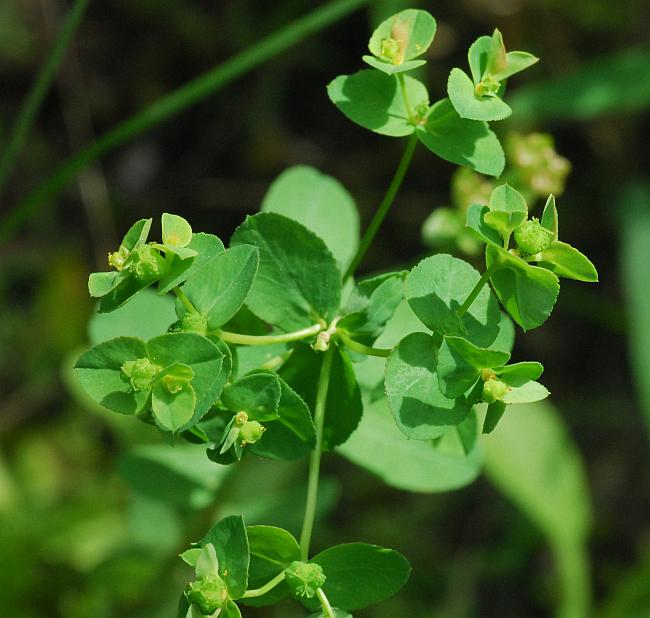Euphorbia spathulata Lam.
Warty Spurge

Native
CC = 5
CW = 3
MOC = 15
© SRTurner
Euphorbia spathulata Lam.Warty Spurge | |
 |
Native CC = 5 CW = 3 MOC = 15 |
© SRTurner |
|
Family - Euphorbiaceae Habit - Taprooted annual forb. Sap milky. Stem - Ascending to erect, to 60 cm, unbranched below the inflorescence or occasionally few-branched, the branches not flattened toward the tip, usually green to yellowish green, sometimes faintly purplish-tinged, glabrous.
Leaves - Alternate above the lowest node and below the inflorescence branches (those of the inflorescence branches usually opposite, those of the basal node opposite or whorled but usually absent at flowering), sessile. Stipules absent. Leaf blades 10-45 mm long, oblanceolate to oblong-oblanceolate (leaves of the inflorescence branches broadly ovate to broadly ovate-triangular), unlobed, rounded to truncate or shallowly cordate at the base and sometimes somewhat clasping the stem, rounded or broadly angled to a bluntly pointed tip, the margins finely toothed mostly above the midpoint (the teeth sometimes minute and visible only with magnification), the surfaces glabrous, yellowish green to green.
Inflorescences - Terminal umbellate panicles with a whorl of leaves at the base and each of the usually 3 primary branches often branched 1-3 additional times, the cyathia solitary at the branch tips and at the branch points.
Flowers - Involucre 0.6-0.9 mm long, glabrous, the rim shallowly 4-or 5-lobed to nearly entire, the marginal glands 4 or 5, 0.1-0.3 mm long, oblong-oval to elliptic or slightly kidney-shaped, greenish yellow to yellow, less commonly reddish, lacking a petaloid appendage. Staminate flowers 3-8 per cyathium. Ovaries glabrous, but the surface densely warty, the styles 0.3-0.8 mm long, each divided 1/4-1/2 of the way from the tip into 2 slightly club-shaped lobes.
Fruit - Schizocarps 2-3 mm long, glabrous but the surface conspicuously warty. Seeds 1.3-1.7 mm long, broadly elliptic-ovate to nearly circular in outline, slightly biconvex in cross-section, rounded at the base, the surface with a fine network of low ridges, reddish brown to dark purplish brown but sometimes appearing slightly glaucous, with a pale, irregularly winglike caruncle, this often breaking off as the seeds are dispersed.
Flowering - May - July. Habitat - Glades, upland prairies, ledges and tops of bluffs, streambanks, ditches, railroads. Origin - Native to the U.S. Lookalikes - E. obtusata, E. commutata. Other info. - This inconspicuous spurge is not particularly common in Missouri, mostly found in a handful of scattered counties in the southern half of the state. The plant occurs across most of the continental U.S. except for Nevada and the far northeast, though as in Missouri it is scattered and often uncommon. The spatulate leaves and warty fruits are clues to the ID. Distinguishing this species from E. obtusata can be difficult, and in fact some authors have lumped it into that species. In E. spathulata, the surfaces of the seeds (not the fruits) have a honeycombed pattern, whereas in E. obtusata they are smooth. Photographs taken in the Ouachita National Forest, Montgomery County, AR, 5-7-2015 (SRTurner). |